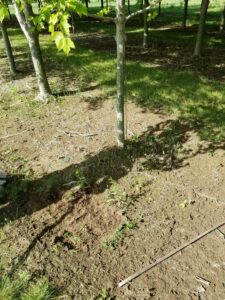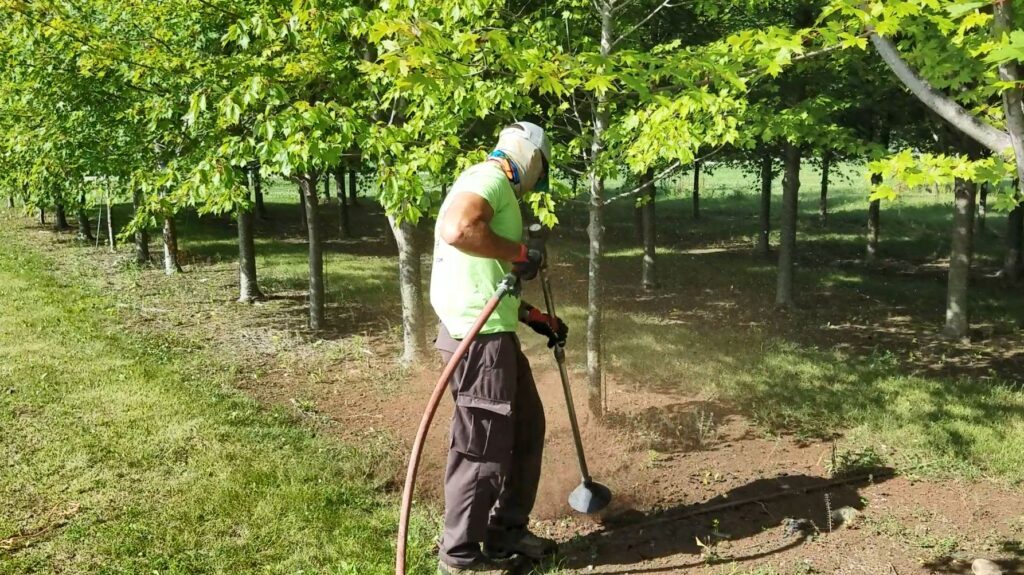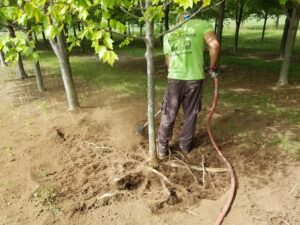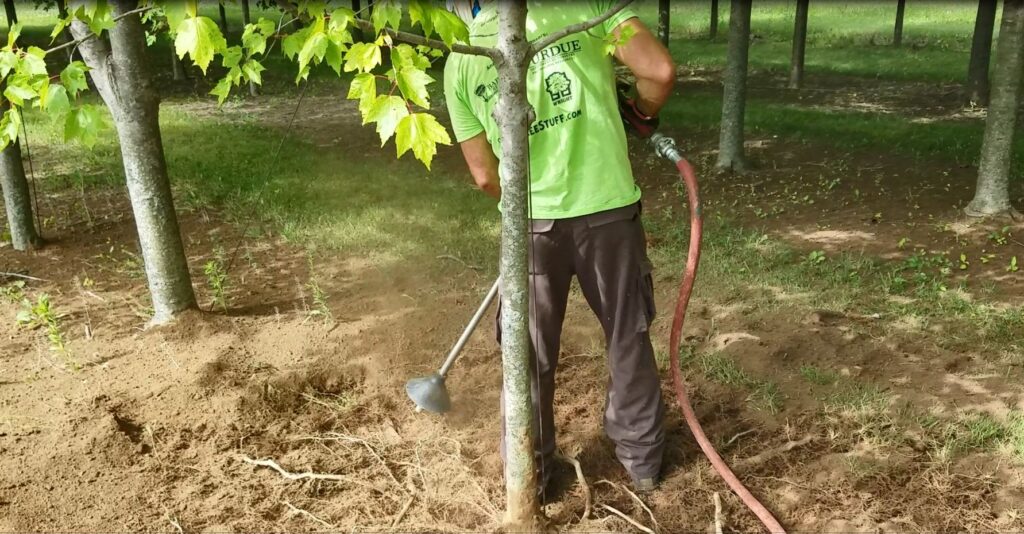When transplanting trees, it is important to consider the long-term viability. Since the typical life span of an urban tree is 7-20 years (USDA), proper establishment techniques are very important to decrease this mortality rate. When a tree becomes established, it is much more difficult to correct below ground problems.
Root deformations can occur for many reasons in established trees, but the most common are due to not making corrections prior to transplanting. Plants that have girdling and circling roots must be addressed at the time of planting. If this issue is not addressed many problems may ensue when the tree is established, which includes decline, tree failure, blow-overs, and more.
- Figure 1. Compacted soils can be alleviated by pneumatic digging tools.
Another common problem that occurs at transplanting is deep planting. In the past, plants were often planted deep in the nursery for two main reasons: 1) cold protection of the roots and root flare and 2) prevent the use of staking. In fields that are cultivated, the soil often mounds around the trees which can increase the depth of the root flare. Additionally, when planting into the landscape, trees can be planted too deep, exacerbating the problems associated with planting too deep.
Deep planting can cause an increase in disease, insects, decreased tolerance to flooded soils, adventitious roots, and root circling/girdling. Day and Harris (2008) found that there is significantly more girdled root at 30 cm below grade than at grade or 15 cm below grade. They also found that excavated trees at 30 cm had more girdling roots than non-excavated roots at 30 cm.
Compaction can become an issue when trees are located in high traffic areas. Compaction will cause a decline in trees over time and become more susceptible to increased insect and disease pressure.
Excavating the root system with a pneumatic digger is a method that can be used to correct all of these problems. Removing soil around the tree will allow root deformations to be located and corrected. Removing the soil around the collar to correct planting depth and girdling roots will increase the longevity of the tree. Compaction can be reduced by using a pneumatic digger to remove the soil from the root hairs that are typically located in the top 6 inches of soil for most trees (Morris, et.al., 2009).
- Figure 3. Exposing roots by using a pneumatic digger can allow a tree care manager to correct root deficiencies and girdling roots around the trunk.
In addition to correcting root problems, this type of root excavation can also be used as a way to install under pipes and irrigation without substantial damage to the roots (Gross and Julene, 2002).
Many certified arborists are familiar with this tool to reduce stress and increase the life span of trees. You can find a certified arborists at https://www.treesaregood.org/findanarborist.
For more information on correcting root problems after a tree becomes established:
Stem Girdling Roots: https://www.purduelandscapereport.org/article/stem-girdling-roots/
Root Growth on Urban Trees: http://hort.ifas.ufl.edu/woody/roots.shtml
Tree Root Problems: http://www.mortonarb.org/trees-plants/tree-and-plant-advice/horticulture-care/tree-root-problems
Air Digging Trench or Loosening Soil: https://hort.ifas.ufl.edu/woody/air-spade.shtml
Tree Planted Too Deeply: https://extension.umd.edu/resource/trees-planted-too-deeply
Roots and the Pneumatic Soil Excavation Tool: https://tcimag.tcia.org/equipment-technology/roots-and-the-pneumatic-soil-excavation-tool/
Tree Preservation Efforts: https://www.scottarboretum.org/tree-preservation-efforts-hydrovac-excavation/
Getting Roots Right: http://www.actrees.org/files/Research/mortonarb_getting_roots_right.pdf#page=50
Supersonic Air Jets Preserve Tree Roots in Underground Pipeline Installation: https://www.fs.usda.gov/treesearch/pubs/26138
Literature Cited:
- Day, S.D. and Harris. J.R. 2008. Growth, survival, and root system morphology of deeply planted Corylus colurna 7 years after transplanting and the effects of root collar excavation. Urban Forestry and Urban Greening. Vol. 7, Issue 2. Pgs. 119-128.
- Gross, R., and Julene, M. 2022. Supersonic air jets preserve tree roots in underground pipeline installation. USDA Forest Service Gen. Tech. Rep. PSW-GTR-184.
- Morris, L., Miller, M., Ingerson, M., Figueroa, D. and Orr, M. 2009. Soil compaction and response to amekioration treatments around established trees in an urban campus environment. Proceeding of the 2009 Georgia Water Resources Conference.



